March 8, 2017
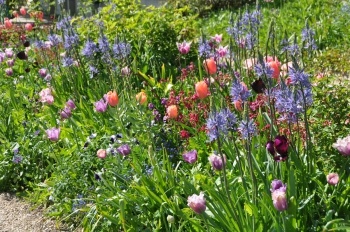
What is so different and appealing with Monet’s flower garden is its very natural look. The gardeners apply themselves to avoid that flowers seem regimented.
It is not as simple as it sounds. We as humans have a tendency to organize. Spontaneously, unconsciously, what we do and make turns out to be regular.
One of the gardeners’ trick for planting bulbs randomly is to throw them on the ground, the bare ground of late Autumn. Where the bulb fell, there it is planted.
This tip works for camassias or tulips. Biennals are planted by color patches that combine different varieties, wallflowers, pansies, violas… Sizes, shapes and hues of the same color help creating the impressionist brushstrokes feeling.
Posted in Giverny, Monet's flower garden 2 Comments »
September 16, 2016

September is a magic time at Giverny. In Monet’s gardens, all the summer flowers had ample time to settle and offer generously their fascinating beauty. It is an endless surprise to discover the latest varieties of giant dahlias, picked out from the thousands of existing cultivars. They combine in the pink border above with cleomes, sages, zinnias, roses and ageratums, displaying all the different tones from pale pink to deep purple.
In yellow beds, it is time for huge sunflowers of all kinds, coreopsis and black eyed Susan, anthemis, and for some contrast the strange shapes of amaranthus caudatus, whose common name I’m not so fond of: ‘Love lies bleeding’.
This sad name is certainly not in tune with the atmosphere of flowery feast that reigns in the Giverny garden. The alleys are full of lovers that walk hand in hand with a happy smile on their faces. The borders are so high in this season that they provide intimacy. It is a wonderful experience to feel merged in flowers.
Posted in Monet's flower garden 2 Comments »
September 16, 2015
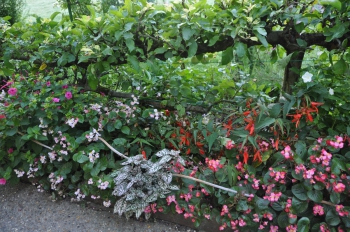 In Monet’s flower garden at Giverny, a beautiful border covers the feet of the espaliered apple trees.
In Monet’s flower garden at Giverny, a beautiful border covers the feet of the espaliered apple trees.
These colorful cushions are made of begonias boliviensis, whose lovely leaves resemble angel wings, combined with pink begonias semperflorens, four o’clock plants and polka dot plants.
The latter is often used in planters but it is also a very nice ground cover, that brings color and doesn’t need deadheading.
According to a keen gardener I met, polka plants are ‘the best thing since sliced bread’. It was the first time I ever heard this funny expression that doesn’t translate into French. Well, you can translate word for word, but it is not a colloquialism and I can’t think of any equivalent.
This is great with foreign languages: you keep learning as long as you talk with native speakers, and sometimes you remember how it felt when you were six and wouldn’t understand exactly what people meant.
And this is what I find so great with my job: sharing with avid gardeners, speaking foreign languages, meeting wonderful people, and walking daily in the little Eden designed by Monet. All this combines like the flowers in the flower bed and makes my life happy and colorful. Thank you to you all.
Posted in Monet's flower garden No Comments »
June 17, 2015
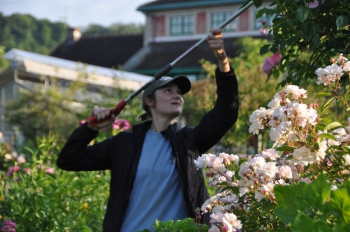
As early as 7 o’clock in the morning, the fairies are at work in Monet’s gardens. Young volunteers carefully take away the wilted flowers to keep the garden full of beautiful blossoms. Climbing roses are reached thanks to secateurs with long handles that need some practice and a lot of attention. The volunteers also have many other tasks to do. Here is Hillary Bernhardt, who was kind enough to answer a few questions:
Do you like this work?
Yes, very much. It’s very special to be able to work in Monet’s garden for a month. I have the opportunity to see how the flowers change in the garden as we take certain flowers out and put new ones in or as new ones pop out of the ground. I feel lucky to be able to soak in the garden’s beauty each day. Additionally, I love the opportunity to visit the garden after hours. It is sometimes challenging to be working outside all day, but I am thankful for the opportunity.
What made you want to apply?
I knew previous students from Davidson College who had completed the internship and they had all loved the experience. It’s a great way to practice speaking the French language, experience French culture, and explore the region on weekends. It’s also an excellent way to reflect on one’s life and journey thus far. As I’m working in the garden or going on bike rides in the area, I have the space to think about what has been meaningful in my life so far and what I would like to do in the future.
How is the atmosphere?
Working in the garden is fun! I enjoy talking to the tourists, especially when I’m able to practice French with them. Many of them ask me for the names of the flowers, but usually they know more of the names than I do! Also it has been enjoyable getting to know the professional gardeners, who really make the magic happen in the garden. I’ve enjoyed joking around with them as I have gotten to know them better.
Posted in Gardening No Comments »
June 13, 2015

Over the main alley that crosses Monet’s garden, the climbing roses display their tender colors in June.
Their pink and red match the pretty colors of the annual poppies scattered everywhere in the flower beds.
(click to enlarge)
Posted in Monet's flower garden 1 Comment »
June 10, 2015
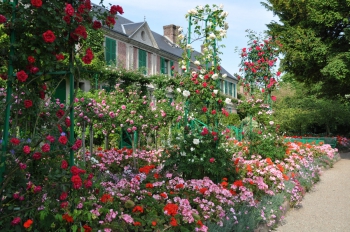
I hope I will live long enough to experience the time when computers will manage to send fragrances. It would be so nice to be able to share the scents of Giverny. The roses are in full bloom, and their delicate perfume fills in the air. In the water garden, it mingles with the sweet scent of honey suckle, creating a very girly combination, the kind of fragrance I loved to wear as a teenager. I wonder if the teenagers of today still like it. But I see everyday how ladies love smelling flowers. To get most of a peony or an iris, the best is to put one’s nose in the petals. It is so good it gets addictive. Is this a feminine gesture, as a female visitor suggested it to me? I remember a photo of Georges Clemenceau smelling a rose. The Tiger himself! With such an example, gentlemen should feel free to indulge in this pleasure.
Posted in Monet's flower garden 1 Comment »
May 25, 2015

In May, a big tree crowns Monet’s flower garden with a beautiful mauve blossom. It is a paulownia, also named princess tree or impress tree. Its color harmonizes with the purples of the alliums in the Norman Enclosure. They combine with the yellows of isatis, their complementary color, for more vibrance.
There is even a more subtle combination. The paulownia is so big that it can be seen from the water garden. It reflects into the pond between the reflections of the wisterias on both sides of the pond. They have exactly the same color and flower the same two weeks, as if they would have organized their annual meeting. Thus they create a connection between the two gardens separate by the road.
Posted in Monet's flower garden 1 Comment »
May 19, 2015
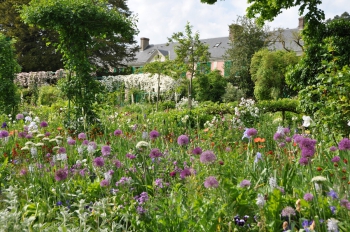
Mid-May, in Monet’s gardens the last tulips that were so colorful are followed by blue and purple flowers: flouncy irises and ball shaped alliums.
Both exist in all sorts of tones from pale to intense.
When planting them, the gardeners pay great attention to their variety, trying not to have two same flowers side by side.
Although they are so numerous, they never produce a mass effect but keep a very natural look, that makes all the charm of Giverny.
Posted in Monet's flower garden No Comments »
April 25, 2015
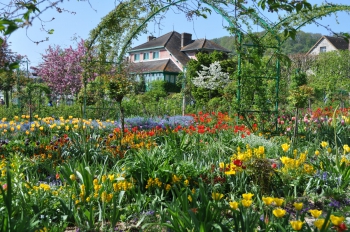
Seen on a map or from the windows of his home, Monet’s flower garden aligns straight lines that ressemble almost a grid. But because Monet raised the flower beds, an oblique look through the garden doesn’t reveal the walkways. Instead, it gives the feeling of an endless flowered meadow full of striking colors. Blues are made by forget-me-not, while tulips, fritillaries and pansies provide all the colors of the painters palette. (Click on picture to enlarge)
Posted in Giverny, Monet's flower garden No Comments »
March 22, 2015

Monet’s house and gardens at Giverny will open next week on Saturday, the 28th of March 2015. If you plan to explore Monet’s place that early in the season, this is more or less what you can expect. The above pic was taken last year on the 2nd of April.
It is an effect I like and that doesn’t last for a long time, daffodils making bouquets on the fresh green lawn. Their planting recalls the way the water lilies float on the surface of the pond in Monet’s water garden.
In April it is still possible to look over the rose bushes planted all around this patch of lawn. Very soon leaves pop out, the border thickens and hides the lawn behind. In the meanwhile, the daffodils will have faded, so we will be only too happy not to see them anymore…
Posted in Monet's flower garden No Comments »
September 14, 2014
[singlepic id=257 w=320 h=240 float=left]
Early in the morning, the low sunbeams stroke the flowers at Giverny. Some mist still hangs in the air, like the dreams of the night. There is a feeling of awakening.
The little lanes of Monet’s garden look even more inviting. Early in the morning, minutes after opening time, the Clos Normand is still silent. One can hear the plants breathing, almost.
It is a magical moment that must be picked up quickly. Shortly later, the air will be full of voices, and the place full of people.
Posted in Giverny, Monet's flower garden 1 Comment »
June 23, 2013
[singlepic id=239 w=320 h=240 float=right]
With the start of the Summer, flowers become a bit mad at Giverny.
They grow crazily in the garden of Claude Monet, enjoying the combination of mild weather and moisture typical for the Seine valley in this time of year.
Poppies, peonies, roses harmonize with eremurus, yellow sweet rocket or Canterbury bells in a charming way.
Wherever you look, you see waves and waves of flowers. No line interrupts them.
The secret of Claude Monet was to rise his flower beds slightly, in order to hide the path behind.
Posted in Monet's flower garden No Comments »
November 23, 2012
[singlepic id=231 w=320 h=240 float=right]While Giverny is closed for the winter, the gardeners of Fondation Monet are busier than ever. They are getting Monet’s gardens ready for next spring. After pulling out the annuals and cutting the perennials down to ground, they prepare the soil and start the planting. Thousands of bulbs must be planted as soon as possible, preferably before frost.
The beds in front of Monet’s home obey the same color schemes every year. Enormous tulips in different shades of pink combine with blue forget-me-not. The trick is to choose a palette of tones ranging from apricot to mauve to obtain an illusion of brushstrokes. The effect lasts longer than expected because early and late blooming tulips are used together. A row of dianthus surrounds the beds.
Next to these most impressive pink tulip beds, a border made with different kinds of yellow wallflowers offers a strong contrast in terms of color, size and shape. This border located under the pink blossom of three crab apple trees is partly shaded. Mauve blue bells scattered among the wall flowers produce an effect of shade and sunshine. The border is lined by white daisies. Last spring the gardeners added white tulips, for a very fresh result.
Posted in Monet's flower garden 3 Comments »
October 4, 2012
[singlepic id=228 w=320 h=240 float=left]This is how the Monet garden at Giverny looks this week. The gently sloping “Norman Enclosure”, Monet’s backyard, offers an explosion of dahlias of all kinds, and amazing sunflowers, black eyed Susans, nicotinias, sages, nasturtiums, asters, cosmos, castor plants, zinnias, marigolds, daturas, fox tails, etc etc.
It is SO beautiful!
All these flowers harmonize by colors in monochromatic flower beds. Here the orange version. You will also see red borders, purple ones, pink ones, yellow ones… The garden is typically impressionist in late season.
In the water garden, the last water lilies float on the pond. The light is ever changing, providing continuously renewed effects. The foliages have started to change their color.
Fall is one of my favorite time at Giverny. I would not be surprised if it would have been Monet’s favorite time too.
Posted in Monet's flower garden 2 Comments »
June 26, 2012
[singlepic id=224 w=320 h=240 float=left]Just an idea of the profusion of roses blooming in June at Giverny!
For a few weeks, Monet’s garden becomes a rose garden.
Rambling, climbing roses climb on dozens of metallic structures, typical for a garden designed in the 19th Century.
Posted in Giverny, Monet's flower garden 7 Comments »









